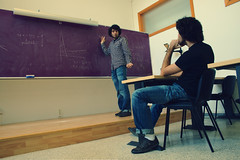My post this week has to do with my reflections as I venture on my quest to create an online Visual Art 20 course for my school. I have wrestled with how much I have to 'teach' them online and how much I have to guide them to find the best resources for their own learning. I am not an art teacher but I have given all of my effort to dissect the curriculum make sure that I am actualizing what is in the document. I am at a struggle in my course creation as to how much prescriptive teaching materials I can give them. I can post up good videos that I have found on certain techniques but I could not create a video on that technique because I do not know it myself.
I struggle with how much I need to be a sage on the stage or a guide on the side with PAA courses. It was no trouble to create a PAA Cosmetology course because this was an area that I had some skill that I could video in hopes of helping and leading the students through the projects that I created for them. In Visual Arts however I am wondering if I am selling the students short by providing the students an open assignment that is something along the lines of : research an aboriginal artist that is of interest of you and then create an art work that is inspired by this artist. Of course the assignment would be much more detailed in terms of expectations and marking rubrics etc. But in terms of providing a video that shows a skill and then says try to replicate it, I am at a loss.
Am I selling my students short to have an open ended assignment that they choose that interests them, where they will have to find their own resources and videos for tips and techniques, or am I providing them the opportunity to follow as other artist have done before?
The barrier to leaving the student to choose their own topic and their own creation is the question: what if they don't learn anything? What if they just 'muck' around for awhile and don't actually produce anything or increase their skill in any particular area? Will that be my fault for not providing enough skill techniques to follow or will the ownership be on the student for not taking ownership of their learning?
Does anyone have any advice? How does a hands on class work online? Is the pedagogy different than in a face to face class? Does online learning mean taking ownership of your own learning and not relying on the teacher as the expert? I am a bit scared of letting go of control; however, in a subject area where the student may have more skill in this area than the teacher can an effective learning environment still be created?




5 comments:
Hi Racquel,
I think that allowing your students to guide their own learning in an open-ended assignment will be really beneficial. I don't think that you're selling them short at all. I think that they'll appreciate that you're giving THEM a choice on what THEY want to learn, and the content might resonate more if they have some control. I did an "inquiry based" project along the same lines with my grade 6's last year, and they LOVED it. It was quite simple, but they had a number of choices and they really went with it. I think that if you provide some structure, such as a mini-lesson each class (maybe you could show them some resource examples, etc.) you can still have some control. I also would conference with the kids to see how they were doing on their projects. I think that the fact that they'll be able to use research skills and technology is reason enough to do the project, kind of like the "journey is as important as the destination." Good luck!
Thanks for the advice Chelsie, I think I am going to go with the open concept assignment and see what happens.
Online learning certainly seems to lend itself to the Constructivist approach. The more reading I do the more I am seeing, at least my Visual Art course, go the constructivist route where students are creating the learning as they go and since each person is unique then each persons process and learning will be unique as they construct meaning through each online course that they take. According to Driscoll "Learners, therefore, are not empty vessels waiting to be filled, but rather active organisms seeking meanting" (pg. 387).
Hope this one comes through—I've never forgotten about this post!
Structured choice would be my recommendation. When I taught art, I'd show the students examples of artists who were working with a similar concept, material or process along with my introduction to the assignment. Sometimes we'd work through an example together to check for understanding and then I'd let them make choices on how to respond within the given parameters. Hope that's helpful!
Thank-you so much for your comments Alison. I am definitely working on the structured choice bit. I think that I should create a unit at the beginning where the purpose would be to get students use to working with different mediums. They could have small very structure tasks that would give them some sense of technique.
Here is the link to the wikispace for the Visual Art 20 course. It is a work in progress
https://visualart20.wikispaces.com
Post a Comment